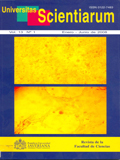Abstract
Toda investigación empieza con una revisión del estado del arte. En las condiciones actuales de exceso de información, surge una nueva dificultad metodológica: de qué manera decidir cómo y qué leer. No es posible leer todo en el tiempo disponible en los estrictos cronogramas de investigación. El uso de herramientas de búsqueda avanzada con las palabras clave que en un primer momento nos parecen útiles, produce demasiadas referencias de calidad no controlada y, lo peor, que no parecen adicionar nuevo conocimiento acerca del tema de interés; situación que contradice el sentido mismo de revisar la literatura científica. Este artículo presenta la forma en que este problema fue recientemente resuelto en un proyecto cuyo propósito fue hallar conceptos y evidencia empírica de utilidad para trazar linderos de áreas de conservación de tal forma que protejan la biodiversidad al evitar que las poblaciones protegidas disminuyan
en tamaño. Explica la necesidad de construir un filtro para elaborar un resumen sistemático de lo que se lee y describe cómo se abordó la revisión bibliográfica; en particular, en relación con la exploración de conceptos clave, la generación de una base de datos refinada y los criterios para decidir qué leer de todo el material obtenido.
Palabras clave: bases de datos, estado del arte, pasos a seguir, revisión.
Abstract
Every investigation starts with a review of the state of the art. In the current conditions of information excess, a new methodological problem emerges: how to decide how and what to read. It is impossible to read everything in the time available in the strict research chronograms. The use of advanced search tools, by using keywords that, at the beginning seem to be relevant, results in too many references of uncontrolled quality and, even worse, that do not seem to add new knowledge about the topic of interest; a situation that contradicts the sense of the revision of the scientific literature. This article presents the way this problem was recently solved in a project which aim was to search for concepts and empirical evidence for defining boundaries of conservation areas in such a way that they protect the biodiversity better by preventing the decrease of protected populations. It explains the need to define a filter for making a systematic summary of what was read and describes how the literature review was undertaken; in particular, concerning the search for key concepts, the generation of a refined data base and the criteria used to decide what to read of all the material obtained.
Key words: databases, review, state of the art, steps to follow.
Univ. Sci. is registered under a Creative Commons Attribution 4.0 International Public License. Thus, this work may be reproduced, distributed, and publicly shared in digital format, as long as the names of the authors and Pontificia Universidad Javeriana are acknowledged. Others are allowed to quote, adapt, transform, auto-archive, republish, and create based on this material, for any purpose (even commercial ones), provided the authorship is duly acknowledged, a link to the original work is provided, and it is specified if changes have been made. Pontificia Universidad Javeriana does not hold the rights of published works and the authors are solely responsible for the contents of their works; they keep the moral, intellectual, privacy, and publicity rights. Approving the intervention of the work (review, copy-editing, translation, layout) and the following outreach, are granted through an use license and not through an assignment of rights. This means the journal and Pontificia Universidad Javeriana cannot be held responsible for any ethical malpractice by the authors. As a consequence of the protection granted by the use license, the journal is not required to publish recantations or modify information already published, unless the errata stems from the editorial management process. Publishing contents in this journal does not generate royalties for contributors.



